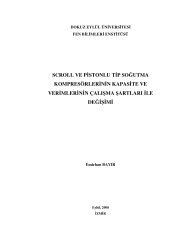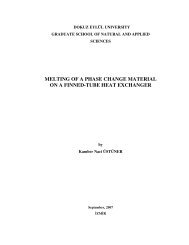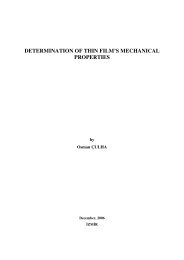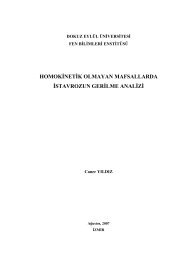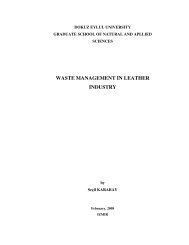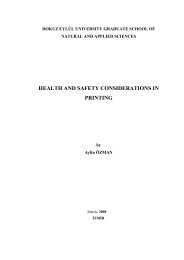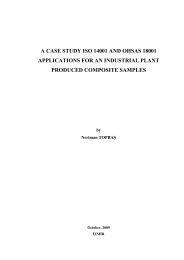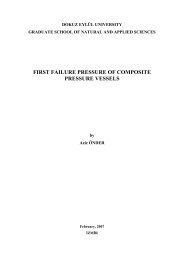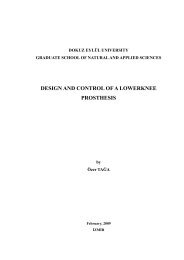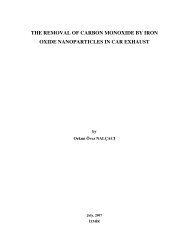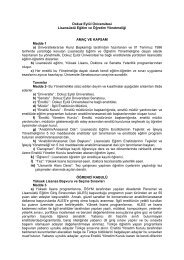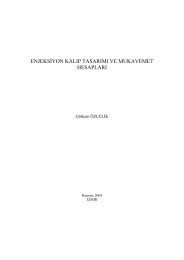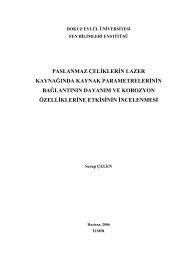FRACTURE BEHAVIOR OF WELDED MIS-MATCHED JOINTS
FRACTURE BEHAVIOR OF WELDED MIS-MATCHED JOINTS
FRACTURE BEHAVIOR OF WELDED MIS-MATCHED JOINTS
You also want an ePaper? Increase the reach of your titles
YUMPU automatically turns print PDFs into web optimized ePapers that Google loves.
DOKUZ EYLÜL UNIVERSITYGRADUATE SCHOOL <strong>OF</strong> NATURAL AND APPLIEDSCIENCES<strong>FRACTURE</strong> <strong>BEHAVIOR</strong> <strong>OF</strong> <strong>WELDED</strong><strong>MIS</strong>-<strong>MATCHED</strong> <strong>JOINTS</strong>byUygar ÇEVİKAugust, 2008İZMİR
<strong>FRACTURE</strong> <strong>BEHAVIOR</strong> <strong>OF</strong> <strong>WELDED</strong><strong>MIS</strong>-<strong>MATCHED</strong> <strong>JOINTS</strong>A Thesis Submitted to the Graduate School of Natural Sciences of Dokuz EylülUniversity in Partial Fulfillment of the Requirements for the Degree of Masterof Science in Mechanical Engineering, Mechanics ProgrambyUygar ÇEVİKAugust, 2008İZMİR
ACKNOWLEDGEMENTSI would like to gratefully acknowledge the helpful encouragement and guidance Ireceived throughout my study from my advisor Assist. Prof. Dr. Çınar Emine Yeni.I would also like to thank my family and my friends for their love, encouragementand constant moral support; their contribution makes it all worthwhile.Uygar ÇEVİKiii
<strong>FRACTURE</strong> <strong>BEHAVIOR</strong> <strong>OF</strong> <strong>WELDED</strong> <strong>MIS</strong>-<strong>MATCHED</strong> <strong>JOINTS</strong>ABSTRACTIn this study, laser beam welded Aluminum Alloy 6056 plates have been used toobtain the crack resistance curves (R-curves) in Compact Tension C(T) specimens.Laser beam welding is a noval joining method used for hard to join materials, such asaluminum alloys, which were considered unweldable formerly. Defect free weldshave been obtained with Nd: YAG type laser. Three types of C(T) specimens havebeen employed for this study, namely, Base Metal (BM), welded specimen withcrack in the Weld Metal (WM) and welded specimen with crack in the Heat AffectedZone (HAZ). Fracture mechanics test have been carried out in order to determine theCrack Tip Opening Displacement (CTOD), Crack Mouth Opening Displacement(CMOD) and crack extension (Δa) values corresponding to the applied load.ABAQUS software has been utilized to carry out the numerical analysis. The inputparameters were the applied load and the crack length. The output parameters wereCTOD, CMOD and J-Integral. Experimental and numerical results have beencompared with various graphics, it can be concluded that they are in good agreementfor all conditions.Keywords: J-Integral, R-Curve, Crack Tip Opening Displacement (CTOD), ElasticPlastic Fracture Mechanics (EPFM), Laser Welding, Aluminum Alloysiv
MUKAVEMET UYUŞMAZLIĞI OLAN KAYNAKLI BAĞLANTILARINKIRILMA DAVRANIŞIÖZBu çalışmada, kompakt çekme C(T) numunelerinde direnç eğrilerini (R-eğrisi)elde etmek için lazer kaynaklı alüminyum alaşım 6056 plakalar kullanılmıştır. Lazerışın kaynağı, klasik yöntemlerle kaynak yapılması mümkün olmayan alüminyumalaşımlar gibi malzemeler için yeni geliştirilmiş bir birleşme metodudur. Buçalışmada kaynak Nd: YAG tipi lazer ile yapılmıştır. Çalışma için üç tip çekmenumunesi kullanılmıştır: Ana Metal (BM), kaynaklanmış Kaynak Metali’nde çatlakbulunduran numune (WM) ve Isıdan Etkilenmiş Bölge’de (HAZ) çatlak bulundurannumune. Kırılma mekaniği testi, uygulanan yüke bağlı olarak Çatlak Ucu AçılmaYerdeğiştirmesi (CTOD), Çatlak Ağzı Açılma Yerdeğiştirmesi (CMOD) ve Çatlakİlerlemesi (Δa) değerlerini belirlemek için yapılmıştır. Nümerik analizler içinABAQUS programı kullanılmıştır. Girdi parametreleri, uygulanan yük ve çatlakuzunluğu, çıktı parametreleri ise CTOD, CMOD ve J-integrali olarak alınmıştır.Deneysel ve nümerik sonuçlar çeşitli grafiklerle karşılaştırılmış ve bu sonuçlarınbütün durumlar için iyi bir uyum gösterdiği görülmüştür.Anahtar Kelimeler: J-İntegrali, R-Eğrileri, Çatlak Ucu Açılma Yerdeğiştirmesi,Elastik Plastik Kırılma Mekaniği (EPKM), Lazer Kaynağı, Aluminyum Alaşımlarv
CONTENTSPageM.Sc. THESIS EXAMINATION RESULT FORM .................................................... iiACKNOWLEDGEMENTS ........................................................................................ iiiABSTRACT ................................................................................................................ ivÖZ ................................................................................................................................ vCHAPTER ONE - INTRODUCTION ..................................................................... 11.1 Laser Welding .................................................................................................... 11.2 Laser Welding Process Principles ...................................................................... 31.3 Laser Welding Calculations ............................................................................... 41.4 Characteristics of the Laser Beam ..................................................................... 61.4.1 Monochromatic ........................................................................................... 61.4.2 Coherent ...................................................................................................... 61.4.3 Culminated .................................................................................................. 61.5 Laser Welding Factors ....................................................................................... 71.6 Metallurgical Considerations ............................................................................. 71.7 Laser Welding Approaches ................................................................................ 81.8 Evaluating Laser Welding Systems ................................................................... 81.9 Aluminum and its Alloys ................................................................................. 101.9.1 Classification of Aluminum Alloys .......................................................... 111.9.1.1 Classification of Wrought Aluminum Alloys .................................... 111.9.1.2 Classification of Cast Aluminum Alloys ........................................... 121.9.2 Wrought Aluminum Alloys 6xxx Series (Aluminum–Magnesium–Silicon)…………………………………………………………………………13CHAPTER TWO - <strong>FRACTURE</strong> MECHANICS .................................................. 152.1 Introduction to Fracture Mechanics ................................................................. 152.2 The Significance of Fracture Mechanics.......................................................... 182.3 Fields of Fracture Mechanics ........................................................................... 20vi
2.3.1 Linear Elastic Fracture Mechanics (LEFM) ............................................. 202.3.2 Elastic Plastic Fracture Mechanics (EPFM) ............................................. 202.4 The Crack Tip Opening Displacement (CTOD) .............................................. 222.5 The R-Curve ..................................................................................................... 252.6 The J-Integral ................................................................................................... 29CHAPTER THREE - INTRODUCTION TO ABAQUS S<strong>OF</strong>TWARE ............. 363.1 Introduction ...................................................................................................... 363.2 The ABAQUS Modules ................................................................................... 373.2.1 ABAQUS/Standard ................................................................................... 373.2.2 ABAQUS/Explicit .................................................................................... 373.2.3 ABAQUS/CAE ......................................................................................... 383.2.4 ABAQUS/Viewer ..................................................................................... 383.2.5 ABAQUS/Aqua ........................................................................................ 383.2.6 ABAQUS/ADAMS ................................................................................... 383.2.7 ABAQUS/CAT ......................................................................................... 393.2.8 ABAQUS/C-MOLD ................................................................................. 393.2.9 ABAQUS/Design ...................................................................................... 393.2.10 ABAQUS/MOLDFLOW ........................................................................ 393.2.11 ABAQUS/Safe ........................................................................................ 39CHAPTER FOUR - DISPLACEMENT GAUGE SYSTEMS FOR <strong>FRACTURE</strong>MECHANICS TESTS ............................................................................................. 404.1. Introduction ..................................................................................................... 404.2. Displacement Gauge For Small Working Ranges Up To 5 mm( δ 5-Compact-Clip)................................................................................................. 42vii
CHAPTER FIVE - MODELLING AND ANALYSIS <strong>OF</strong> C(T) SPECIMENUSING ABAQUS ..................................................................................................... 445.1 Introduction .................................................................................................... 445.2 Modelling Base Metal Specimen ................................................................... 445.3 Modelling of The Specimen With A Crack In Weld Region ......................... 545.4 Modelling of The Specimen With A Crack In The Heat Affected Metal ...... 56CHAPTER SIX - RESULTS AND DISCUSSION ................................................ 58CHAPTER SEVEN - CONCLUSIONS ................................................................. 63REFERENCES ......................................................................................................... 64viii
CHAPTER ONEINTRODUCTION1.1 Laser WeldingAlmost 20 years ago, laser welding was in its infancy and used primarily forexotic applications where no other welding process would be suitable. Today, laserwelding is a full-fledged part of the metalworking industry, routinely producingwelds for common items such as cigarette lighters, watch springs, motor/transformerlamination, hermetic seals, battery and pacemaker cans, hybrid circuit packages andalso in automotive and aerospace applications. Yet not enough manufacturingengineers have seriously considered employing lasers in their own operations.Why? There are many reasons, but a primary one must be an unfamiliarity withthe operation and capabilities of a laser system. Other reasons, such as a relativelyhigh initial cost and a concern about using lasers in the manufacturing environment,also are frequently cited.Laser welding could be used in place of many different standard processes, suchas resistance (spot or seam), submerged arc, RF induction, high-frequency resistance,ultrasonic and electron-beam welding. While each of these techniques hasestablished an independent niche in the manufacturing world, the versatile laserwelding approach has the ability to operate efficiently and economically in manydifferent applications. Its versatility will even permit the welding system to be usedfor other machining functions, such as cutting, drilling, scribing, sealing andserializing.Actually, there are many benefits laser welding can offer to manufacturingengineers. Some industry observers state that there are already 2,000 laser machinetools being used for cutting, welding and drilling and that the number could reach30,000 over the next 15 years as manufacturing engineers become more aware of the1
2capabilities of lasers. While most laser applications are dedicated to one product orprocess that involves high-volume, long-run manufacturing, the versatility of a laserto supply energy to hard-to-reach spots, vary the output energy over a wide range,operate under the control of computers and robots and put minimum heat into thepart, makes laser welding ideal for many flexible manufacturing operations.Advantages of laser welding over other conventional welding techniques arepresented in Table 1.1.Table 1.1. Advantages of Laser Welding Compared to Other ProcessesCompeting ProcessAdvantages of Laser WeldingGas Metal ArcSubmerged ArcResistance WeldingElectron BeamFaster welding rates by an order of magnitude; low distortion;no filler metal required; single-pass two-side weldingFaster welding rates; low distortion; no flux or filler neededNon-contact, eliminating any debris buildup; can reachotherwise inaccessible locations; faster welding ratesDoes not need to be performed in a vacuum; on-lineprocessing; shorter cycles and higher uptimes; welds magneticmaterials; does not require radiation shieldingWelding results when materials are heated to a molten state as in fusion weldingtechniques or while they are still in solid state as in friction stir welding. Lasersgenerate light energy that can be absorbed into materials and converted to heatenergy. By employing a light beam in the visible or infrared portion of theelectromagnetic spectrum, we can transmit this energy from its source to thematerial, using delivery optics which can focus and direct the energy to a very small,precise point. Since the laser emits coherent radiation, the beam of energy hasminimal divergence and can travel large distances without significant loss of beamquality or energy.What does all this mean to the manufacturing engineer? To appreciate thepotential of employing lasers in welding operations, some of the traditional
3approaches must be redefined in order to view "efficiency", as it relates to energyconversion. The laser is a relatively inefficient converter of electrical energy intooutput light, with the best lasers achieving only 2 to 15 percent energy conversion,depending upon the type of laser being used. However, virtually all of this outputlight energy is delivered to a small spot, as small as a few hundreds of a milimetersor less.Consequently, for applying thermal energy to small areas, there are no othermethods as efficient as lasers. This ability to selectively apply energy offers somedistinctive metallurgical advantages in some welding applications, but also createssome unique problems. Since the surface heating generated by the laser light reliesupon the material's heat conductivity to produce the weld, penetration is usuallylimited to less than 10 millimeters. By using a technique known as "key holing,"higher power lasers (>106 W/cm²) can make deeper penetrations.By heating the spot of laser focus above the boiling point, a vaporized hole isformed in the metal. This is filled with ionized metallic gas and becomes an effectiveabsorber, trapping about 95 percent of the laser energy into a cylindrical volume,known as a keyhole. Temperatures within this keyhole can reach as high as25,000°C, making the key holing technique very efficient. Instead of heat beingconducted mainly downward from the surface, it is conducted radially outward fromthe keyhole, forming a molten region surrounding the vapor. As the laser beammoves along the work-piece, the molten metal fills in behind the keyhole andsolidifies to form the weld. This technique permits welding speeds of hundreds ofcentimeters per minute or greater, depending on laser size.1.2 Laser Welding Process PrinciplesGenerally, there are two types of lasers that are being used for welding operation:CO 2 and Nd:YAG.
4Both CO 2 and Nd:YAG lasers operate in the infrared region of theelectromagnetic radiation spectrum, invisible to the human eye. The Nd:YAGprovides its primary light output in the near-infrared, at a wavelength of 1.06microns. This wavelength is absorbed quite well by conductive materials, with atypical reflectance of about 20 to 30 percent for most metals. The near-infraredradiation permits the use of standard optics to achieve focused spot sizes as small as0.25 mm in diameter.On the other hand, the far infrared (10.6 micron) output wavelength of the : CO 2laser has an initial reflectance of about 80 percent to 90 percent for most metals andrequires special optics to focus the beam to a minimum spot size of 0.75 to 1 mmdiameter. However, whereas Nd:YAG lasers might produce power outputs up to 500watts, : CO 2 systems can easily supply 10,000 watts and greater.As a result of these broad differences, the two laser types are usually employedfor different applications. The powerful: CO 2 lasers overcome the high reflectance bykey holing, wherein the absorption approaches blackbody. The reflectivity of themetal is only important until the keyhole weld begins. Once the material's surface atthe point of focus approaches its melting point, the reflectivity drops withinmicroseconds.1.3 Laser Welding CalculationsKnowing the size of the focused spot is helpful in calculating energy density atthe work surface. In performing a laser weld, optics to focus the laser beam to thedesired size are necessary.For a fundamental mode (TEM 00 ) beam:( 4 / ) ( / )S = l p × F D(1.1)where:
5S = Focused Spot Diameterl = Laser WavelengthF = Focal Length of Objective LensD = Diameter of Laser BeamFor a multimode beam:S = F× f(1.2)where:F = Focal Length of Objective LensM = Laser Beam DivergenceIf one assumes the part to be welded as a semi-infinite solid, with a constantincident heat flux, then the temperature distribution as a function of depth into thematerial is given by:( )2( , ) = ( 2 / ) × ⎡ ( / ) × exp ( − /4 ) −( /2) /2( )1/2 1/2T x t E K kt p x kt x erfc x kt⎣⎤⎦(1.3)where:T( x,t ) =Temperature at a distance x below the work surface, at a time t after start ofconstant heat inputE = constant heat flux inputK = thermal conductivityk = thermal diffusivityx = depth below surfacet = time after start of heat flux inputerfc = complimentary error functionand at the surface x = 0 , the temperature rise will be:
6( , ) ( 2 / ) ( / ) 1/2T x t = E K × kt p(1.4)x= 01.4 Characteristics of the Laser BeamThe main characteristics of the laser beam can be listed as follows:1.4.1 MonochromaticAll of the photons which compose the beam are of the same energy and thereforethe same wavelength. If the laser beam was directed through an optical prism it couldnot split up into the separate colors representing the wavelengths of the opticalspectrum.1.4.2 CoherentThe light waves are in phase (in step). The meaning of "coherent" light is asfollows: Light moves in the form of a wave, with crests and troughs. Like all otherkinds of electromagnetic radiation, it can be characterized both by its frequency, ornumber of wave crests passing a given point per second, and by its wavelength, ordistance between wave crests. (Beams of such radiation travel through a vacuum atthe highest velocity anything can achieve; see relativity.) Different wavelengths oflight are seen as different colors.1.4.3 CulminatedThe laser beam does not diverge. It can be projected great distances withoutsignificant spreading. For example, it is used for topographical surveys whereelevations miles away can be measured from a single, central location. Culminationmakes is possible for laser beams to target satellites, etc. at great distance.
7Because of these three characteristics the laser beam can be precisely focused tovery small diameters, resulting in an enormous increase in energy density.1.5 Laser Welding FactorsThermal diffusivity, mentioned in the above calculations, is a measure of theability of the material to conduct heat. The lower the diffusivity, the more the heatremains in the vicinity of the laser beam spot.Metals with low boiling points produce a large amount of metal vapor whichcould initiate gas breakdown and plasma generation in the region of high beamintensity just above the metal surface. This plasma, which readily absorbs the laserenergy, can block the passing beam, and bubbles tend to form at the root of the weld.If the viscosity is high, these bubbles do not escape before the molten metalsolidifies.Although the melting point of metals does not have a significant effect on laserweldability, it must be reached during the initial absorption of energy. Thus, lowmelting point materials are easier to weld with a laser than high melting point metals.1.6 Metallurgical ConsiderationsThe effect of welding on various materials depends upon many of theirmetallurgical properties such as "hot strength." After the applied energy is removed,the melt pool solidifies and then it slowly cools to the same temperature as thesurrounding material. During this cooling, the material contracts, creating tensilestresses in the fusion zone. Materials that have a low tensile strength at temperaturesnear their melting point are said to exhibit "hot shortness," which often results incracks appearing in the weld.Similarly, other thermal transformations, such as the martensitic transformation ofhigh carbon steel, also can lead to cracking in or near the weld. To overcome this
8tendency, special precautions such as pre- and post-welding heating of the material isnecessary. However, virtually no thermal distortion occurs during laser welding. Thelower heat input requirement has other benefits, such as being able to use fixturesthat do not need to withstand large thermal expansion forces or to act as heat sinks.Chemical reactions, such as oxidation or nitriding, with atmospheric gases at hightemperatures can pose problems, particularly when the oxides or other elementsformed have disassociation temperatures far above the melting point of the metal.The result is brittle, porous welds. Covering the welding area with an inert gas suchas argon or helium minimizes these reactions in most cases. For some materials, itmay be necessary to weld within a sealed chamber to prevent outside contamination.1.7 Laser Welding ApproachesThere are two different approaches to laser welding. One is the low-powermethod for relatively thin materials; and the other is the "brute force" high-powerapproach that generally involves key holing. In both cases, since filler material israrely used, a tight fitup of the parts being welded is necessary. For butt and seamwelds, the laser energy is applied to the junction of the materials, minimizing heatinput and distortion and permitting high processing speeds.For lap joints, the tolerances for seam alignment are somewhat looser. The widthof the weld is the major consideration. The upper material forms most of the fusionzone so that a good laser-weldable material could be welded to less suitable materialby putting the former material on top.1.8 Evaluating Laser Welding SystemsThe two laser types being used for laser welding, namely CO 2 and Nd:YAG, canoperate in either the continuous or the pulsed mode. CO 2 lasers, which range inpower from 50 to 15,000 watts, are more efficient in their conversion of electricalpower to laser radiation than Nd:YAG lasers, which range from about 50 to 800
9watts output power. However, as mentioned above, the reflectivity of most metals ismuch higher at the CO 2 wavelength than the Nd:YAG wavelength.Recent advances in fast-axial-flow CO 2 lasers provide improved beamcharacteristics, making these systems competitive with electron beam welding fordeep-penetration applications. Fast-spiral-flow CO 2 lasers now are able to producefundamental-mode outputs in the kilowatt range, which gives higher energy densitiessuitable for welding thermally sensitive alloys or materials where thermal distortionis a problem.Slow-axial-flow lasers with enhanced pulsed capabilities offer an advantage overfast-axial-flow units for applications requiring rapid energy coupling and low heatinput. In pulsed operation, the peak power in the pulse is several times greater thanthe continuous-wave power, although the average power is lower. This peak powerovercomes surface reflectivity and minimizes thermal damage to the surroundingmaterial.Solid state lasers (the generic name for Nd:YAG, Nd:Glass and similar lasers), arepreferred for low- to moderate- power applications. They have found extensiveapplications in the electronic/electrical industries for spot welding and beam leadwelding integrated circuits to thin film interconnecting circuits on a substrate.One consideration that can be important in evaluating laser welding is thephysical size of the equipment. Solid state laser welding systems are relatively smallcompared to CO 2 systems, which could occupy an average room to achieve the highpowers required. For delicate welding operations, such as welding lamp filaments,the solid state welding systems offer the advantage of coaxial viewing optics. Sincethe wavelength of the Nd:YAG laser is close to the visible spectrum, standard lensescan transmit both the laser light and the image of the workpiece.
101.9 Aluminum and its AlloysAluminum is a silverish white metal that has a strong resistance to corrosion andlike gold, is rather malleable. It is a relatively light metal compared to metals such assteel, nickel, brass, and copper with a specific gravity of 2.7. Aluminum is easilymachinable and can have a wide variety of surface finishes. It also has goodelectrical and thermal conductivities and is highly reflective to heat and light.At extremely high temperatures (200-250°C) aluminum alloys tend to lose someof their strength. However, at subzero temperatures, their strength increases whileretaining their ductility, making aluminum an extremely useful low-temperaturealloy.Aluminum alloys have a strong resistance to corrosion which is a result of anoxide skin that forms as a result of reactions with the atmosphere. This corrosive skinprotects aluminum from most chemicals, weathering conditions, and even manyacids, however alkaline substances are known to penetrate the protective skin andcorrode the metal.Aluminum also has a rather high electrical conductivity, making it useful as aconductor. Aluminum connectors have a tendency to become loosened after repeatedusage leading to arcing and fire, which requires extra precaution and special designwhen using aluminum wiring in buildings.Aluminum is a very versatile metal and can be cast in any form known. It can berolled, stamped, drawn, spun, roll-formed, hammered and forged. The metal can beextruded into a variety of shapes, and can be turned, milled, and bored in themachining process. Aluminum can be riveted, welded, brazed, or resin bonded. Formost applications, aluminum needs no protective coating as it can be finished to lookgood, however it is often anodized to improve color and strength.
111.9.1 Classification of Aluminum AlloysClassification of aluminum alloys is established by the International AlloyDesignation System (IADS), based on the classification developed by AluminumAssociation of the United States. This classification is accepted by most countries.1.9.1.1 Classification of Wrought Aluminum AlloysEach wrought aluminum alloy is designated by a four digit number. The first digitindicates the alloy group according to the major alloying element. The second digitindicates modification of the alloy or impurity limits. Original (basic) alloy isdesignated by “0” as the second digit. Numbers 1…9 indicate various alloymodifications with slight differences in the compositions:Table 2.1. Classification of Wrought Aluminum AlloysAlloy DesignationAlloying Elements1xxxAluminum 99.0% minimum2xxx Copper (1.9%...6.8%)3xxx Manganese (0.3%...1.5%)4xxx Silicon (3.6%...13.5%)5xxx Magnesium (0.5%...5.5%)6xxx Magnesium and Silicon (Mg 0.4%...1.5%, Si 0.2%...1.7%)7xxx Zinc (1%...8.2%)8xxxOthersIn the alloys of the 1xxx series the second digit indicates modifications inimpurity limits: 0 means natural impurity limit, 1…9 indicate special control of oneor more impurities or alloying element. For example:1070 or 1170 mean minimum 99.70% of aluminum in the alloys, 1050 or 1250mean 99.50% of aluminum in the alloys, 1100 or 1200 mean minimum 99.00% ofaluminum in the alloys.
12In all other groups of aluminum alloys (2xxx through 8xxx) the last two digitssignify different alloys in the group.1.9.1.2 Classification of Cast Aluminum AlloysEach cast aluminum alloy is designated by a four digit number with a decimalpoint separating the third and the forth digits. The first digit indicates the alloy groupaccording to the major alloying element. The second two digits identify aluminumalloy or indicate the alloy purity:Table 2.2. Classification of Cast Aluminum AlloysAlloy DesignationAlloying Elements1xxxAluminum 99.0% minimum2xxx Copper (4%...4.6%)3xxxSilicon (5%...17%) with added copper and/or magnesium4xxx Silicon (5%...12%)5xxx Magnesium (4%...10%)7xxx Zinc (6.2%...7.5%)8xxxTin9xxxOthersIn the alloys of the 1xx.x series the second two digits indicate the level of purityof the alloy – they are the same as the two digits to the right of the decimal point inthe minimum concentration of aluminum (in percents): 150.0 means minimum99.50% of aluminum in the alloy, 120.1 means minimum 99.20% of aluminum in thealloy.In all other groups of aluminum alloys (2xx.x through 9xx.x) the second twodigits signify different alloys in the group.
13The last digit indicates the product form: casting (designated by “0”) or ingot(designated by “1” or “2” depending on chemical composition limits.)A modification of the original alloy or impurity limits is indicated by a serialletter before the numerical designation. The serial letters are assigned in alphabeticalorder starting with A but omitting I, O, Q, and X (the letter “X” is reserved forexperimental alloys).1.9.2 Wrought Aluminum Alloys 6xxx Series (Aluminum–Magnesium–Silicon)6xxx series aluminum alloys include magnesium (Mg) and silicon (Si) as themajor alloying elements and copper (Cu), manganese (Mn), chromium (Cr), zinc(Zn), boron (B), lead (Pb) and bismuth (Bi) may be added to these alloys as minoralloying elements.Alloys in the 6xxx series contain silicon and magnesium approximately in theproportions required for formation of magnesium silicide (Mg2Si), thus making themheat treatable. Although not as strong as most 2xxx and 7xxx alloys, 6xxx seriesalloys have good formability, weldability, machinability, and relatively goodcorrosion resistance, with medium strength.Alloys in this heat-treatable group may be formed in the T4 temper (solution heattreated but not precipitation heat treated) and strengthened after forming to full T6properties by presipitation heat treatment.Aluminum-magnesium-silicon alloys are used in aircraft and automotiveapplications, in architectural applications and as structural material. Some of thecommon applications are handrails, drive shafts, automotive frame sections, bicycleframes, tubular lawn furniture, scaffolding, stiffeners and braces used on trucks,boats and many other structural fabrications.
14For these heat-treatable alloys, an increased loss in tensile strength and elongationcompared to 5000 series alloys was noted for welds tested in the as-weldedcondition. The reduction in weld tensile strength for the precipitation-hardened alloyswas caused by the re-solution of precipitates and/or strain hardening in weld metal.The HAZ also was softened by overaging during welding. The hardness resultsshowed that the hardness value decreased 25 percent compared to the parent material[Vickers Hardness (Hv)150 for the parent material, Hv113 for the HAZ, and Hv110for the weld metal].The tensile failure strengths of the 1.6-millimeter-thick 6082 aluminum alloywere generally between 85 and 90 percent of the base metal strength for theautogenous and wire feed welds (using aluminum-silicon 4043A and aluminummagnesium5556A filler), with elongation to failure of 4 to 12 percent. Theelongation-to-failure values for welds made with 4043A wire were low compared tothe 5556A wire.
CHAPTER TWO<strong>FRACTURE</strong> MECHANICS2.1 Introduction to Fracture MechanicsThrough the ages the application of materials in engineering design has poseddifficult problems to mankind. In the Stone Age, the problems were mainly in theshaping of the material. In the early days of the Bronze Age and the Iron Age, thedifficulties were both in production and shaping. For many centuries metal-workingwas laborious and extremely costly. Estimates go that the equipment of a knight andhorse in the thirteenth century was of the equivalent price of a Centurion tank inWorld War II.With the improving skill and metal working, applications of metals in structuresincreased progressively. Later it was experienced that structures built of thesematerials did not always behave satisfactorily, and unexpected failures oftenoccurred. Detailed descriptions of castings and forgings produced in the Middle Agesexist. When judged with present day knowledge, these production methods musthave been liable to build important technical deficiencies into the structure. Thismust have made gunners pray-when igniting the charge -that the projectile would beproperly delivered and the barrel not blown up.The vastly increasing use of metals in the nineteenth century caused the numberof accidents and casualties to reach unknown levels. The number of people killed inrailway accidents in Great Britain was in the order of two hundred per year duringthe decade 1860-1870. Most of the accidents were a result of derailing caused byfractures of wheels, axles or rails. Anderson has recently made an interestingcompilation of accident reports from the last two hundred years. A few quotationsfollow:15
16"On the 19th of March 1830 about 700 persons assembled on the Montrosesuspension bridge to witness a boat race when one of the main chains gave way...and caused considerable loss of life.""On the 22nd of January 1866, a portion of the roof of the Manchester railwaystation fell, causing deaths of two men. The accident was caused by failure of castironstruts connected...""The failure of a large gas tank in New York occurred on December 13, 1898,killing and injuring a number of people and destroying considerable surroundingproperty.""A high pressure water main burst at Boston. January 3, 1913 and flooded thedistrict..,""Engineering, February 1866. With some fifty to sixty boiler explosions annuallyin the United Kingdom attended as they are with loss of many lives and destructionof property, is it not time that the Government should appoint a commission toinquire into the subject.”Some of these accidents were certainly due to a poor design, but it was graduallydiscovered that material deficiencies in the form of pre-existing flaws could initiatecracks and fractures. Prevention of such flaws would improve structuralperformance. Better production methods, together with increasing knowledge andcomprehension of material properties led to a stage where the number of failures wasreduced to more acceptable levels.A new era of accident prone structures started with the introduction of all-weldeddesigns. Out of 2500 Liberty ships built during World War II. 145 broke in two andalmost 700 experienced serious failures. The same disaster struck many bridge andother structures. Information on these failures was also given by Anderson and morespecifically e.g. by Biggs.
17The failures often occurred under conditions of low stresses (several ships failedsuddenly while in the harbor) which made them seemingly inexplicable. As a result,extensive investigations were initiated in many countries and especially in the UnitedSates of America. This work has revealed that here again, flaws and stressconcentrations (and to a certain extent internal stresses) were responsible for failure.The fractures were truly brittle: they were accompanied by very little plasticdeformation. It turned out that the brittle fracture of steel was promoted by lowtemperatures and by conditions of triaxial stress such as may exist at a sharp notch ora flaw. Under these circumstances structural steel can have cleavage fracture withoutnoticeable plastic deformation. Above a certain temperature, called the transitiontemperature, the steel behaves in a ductile manner. The transition temperature maygo up as a result of the heat cycle during the welding process.At present, brittle fractures of welded structures built out of low strengthstructural steels can be satisfactorily prevented. It has to be ensured that the materialis produced to have a low transition temperature and that the welding process doesnot raise the ductile-brittle transition. Large stress concentration should be avoidedand the welds should be checked to be virtually free of defects.Figure 2.1. Introduction of high strength materials for structural applicationsAfter World War II the use of high strength materials has increased considerably.These materials are often selected to realize weight savings. Simultaneously, stressanalysis methods were developed which enable a more reliable determination oflocal stresses. This permitted safety factors to be reduced resulting in further weightsavings. Consequently, structures designed in high strength materials have only lowmargins of safety. This means that service stresses (sometimes with the aid of an
18aggressive environment) may be high enough to induce cracks, particularly if preexistingflaws or high stress concentrations are present. The high strength materialshave a low crack resistance (fracture toughness): the residual strength under thepresence of cracks is low. When only small cracks exist, structures designed in highstrength materials may fail at stresses below the highest service stresses they weredesigned for.Low stress fractures induced by small cracks are, in many aspects, very similar tothe brittle fractures of welded low-strength steel structures. Very little plasticdeformation is involved; the fracture is brittle in an engineering sense, although themicromechanism of separation is the same as in ductile fracture. The occurrence oflow stress fracture in high strength materials induced the development of FractureMechanics.Engineering fracture mechanics can deliver the methodology to compensate theinadequacies of conventional design concepts. The conventional design criteria arebased on tensile strength, yield strength and buckling stress. These criteria areadequate for many engineering structures, but they are insufficient when there is thelikelihood of cracks. Now, after approximately two decades of development, fracturemechanics have become a useful tool in design with high strength materials.2.2 The Significance of Fracture MechanicsThe object of fracture mechanics is to provide quantitative answers to specificproblems concerning cracks in structures. As an illustration, consider a structurecontaining pre-existing flaws and/or in which cracks initiate in service. The cracksmay grow with time owing to various causes (for example fatigue, stress corrosion,creep) and will generally grow progressively faster. The residual strength of thestructure, which is the failure strength as a function of crack size, decreases withincreasing crack size. After a time the residual strength becomes so low that thestructure may fail in service.
19Figure 2.2. The engineering problem of a crack in a structureWith respect to Fig. 2.2, fracture mechanics should attempt to provide quantitativeanswers to the following questions:• What is the residual strength as a function of crack size?• What crack size can be tolerated under service loading, i.e. what is themaximum permissible crack size?• How long does it take for a crack to grow from a certain initial size, forexample the minimum detectable crack size, to the maximum permissiblecrack size?• What is the service life of a structure when a crack-like flaw (e.g. amanufacturing defect) with a certain size is assumed to exist?• During the period available for crack detection how often should the structurebe inspected for cracks?The field of fracture mechanics is divided into two parts, namely Linear ElasticFracture Mechanics (LEFM) and Elastic-Plastic Fracture Mechanics (EPFM).
202.3 Fields of Fracture MechanicsThe field of fracture mechanics is divided into two parts, namely Linear ElasticFracture Mechanics (LEFM) and Elastic-Plastic Fracture Mechanics (EPFM).2.3.1 Linear Elastic Fracture Mechanics (LEFM)Linear Elastic Fracture Mechanics (LEFM) first assumes that the material isisotropic and linear elastic. Based on the assumption, the stress field near the cracktip is calculated using the theory of elasticity. When the stresses near the crack tipexceed the material fracture toughness, the crack will grow.In Linear Elastic Fracture Mechanics, most formulas are derived for either planestresses or plane strains, associated with the three basic modes of loadings on acracked body: opening, sliding, and tearing.Again, LEFM is valid only when the inelastic deformation is small compared tothe size of the crack, what we called small-scale yielding.2.3.2 Elastic Plastic Fracture Mechanics (EPFM)If the plastic zone ahead of the crack is significantly large then the problem has tobe treated elasto-plastically. Due to its complexity the concepts of Elastic-PlasticFracture Mechanics (EPFM) are not so well developed as LEFM theory, a fact that isreflected in the approximate nature of the eventual solutions.In 1961 Wells introduced the crack opening displacement (COD) approach. Thisapproach focuses on the strains in the crack tip region instead of the stresses, unlikethe stress intensity approach. In the presence of plasticity a crack tip will blunt whenit is loaded in tension. Wells proposed to use the crack flank displacement at the tipof a blunting crack, the so-called crack tip opening displacement (CTOD) as afracture parameter (see figure 2.3.).
21Figure 2.3. Crack tip opening displacement.Even for tougher materials exhibiting considerable plasticity, critical CTODvalues could be defined corresponding to the onset of fracture. Such critical CTODvalues could then be used to qualify the materials concerned for a given application.However, initially it proved difficult to determine the required CTOD for a givenload and geometry or alternatively to calculate critical crack lengths or loads for agiven material.In 1968 Rice considered the potential energy changes involved in crack growth innon-linear elastic material. Such non-linear elastic behavior is a realisticapproximation for plastic behavior, provided no unloading occurs in any part of thematerial. Rice derived a fracture parameter called J, a contour integral that can beevaluated along any arbitrary path enclosing the crack tip. He showed J to be equalto the energy release rate for a crack in non-linear elastic material, analogous to G forlinear elastic material.For simple geometries and load cases the J integral can be evaluated analytically.However, in practice, finite element calculations are often required. In spite of this, Jhas found widespread application as a parameter to predict the onset of crack growthin elastic-plastic problems. Later it was found that J could also be used to describe alimited amount of stable crack growth.
222.4 The Crack Tip Opening Displacement (CTOD)The crack tip opening displacement (CTOD), formerly the crack openingdisplacement (COD) was first proposed by Wells to describe the fracture behavior inthe vicinity of the crack tip. It was conjectured that the opening of the notch faces,namely the crack tip opening displacement, could be used to characterize thisbehavior. Because CTOD measurements can be made when there is a considerableamount of plastic flow ahead of the crack, this technique may be used to establishcritical design stresses or crack sizes in a quantitative manner similar to that ofLEFM.Early in the development of this extension, a check was made to see whether thiscriterion was in agreement with the existing LEFM formulation. In the case ofLEFM, the elastic solution for the opening of the notch faces, 2ν , as a function of x1is given by:4σ2 22ν = ( a − x ) 0.51(2.1)Ewhere the origin of the coordinate system is at the center of the through thicknesscrack. However, by applying the Irwin plastic zone correction, namely equation (2.1)becomes:22(( a r ) x ) 0.514σν = + − (2.2)E2ywherea+ r is the effective crack size. The CTOD is found by setting x 1= a inyequation (2.2) and since r y a, it turns out that:24σ0.5 4KIδ = CTOD = ( 2ary)E= π Eσ(2.3)ys
23Equation (4.3) holds in the area of LEFM: fracture occurs atKIcwhich is aconstant value of CTOD thereby implying that a CTOD fracture criterion applies.According to Broek, the use of this criterion in LEFM requires the measurementof the CTOD, which is difficult and virtually impossible in a routine test. However,indirectly by substituting equation (2.3) into equation (2.2), and recalling that r yissmall, it follows that:24σ⎡2 2 ⎛E⋅CTOD⎞⎤2ν= ⎢a− x1+ ⎜ ⎟ ⎥E ⎢⎣⎝ 4σ⎠ ⎥⎦0.5(2.4)By measuring 2ν mat x 1= 0 , the Crack Mouth Opening Displacement, (CMOD),the CTOD may be inferred. It is possible to relate the applied stress to the cracklength. For stresses < 0.75σys, a good approximation for CTOD is:2πσ aδ = CTOD = (2.5)E σyswhich is the same as equation (2.3), apart from a 4/π factor. In general then:( 1−ν)2 2KIδ = CTOD = (2.6)Eλσ2where the ( 1 ν )ys− factor is deleted for plane stress situations. Various theories havefound 1 < λ < 2.14, while direct measurements have yielded λ in the order of unity.Returning to equation (2.5) or equation (2.6) with λ = 1, and since E = σ / e , itfollows that:ysys
242⎛ K ⎞I= ⎜ysσ ⎟ysδe⎝⎠(2.7)Furthermore, the elastic strain energy release rate G becomes in terms of δ :G = δσ ys(2.8)which, at the onset of crack instability wherecase:KIreachesKIc, dictates for the elasticδceys⎛K⎜⎝σIc= ⎜ ⎟ys⎞⎟⎠2(2.9)Thus, based solely on a comparison with LEFM techniques, the CTOD approachis compatible with the K approach in the plastic regime. It also extends naturally intothe elastic-plastic case.The application of the CTOD approach requires the measurement of δ . After aconsiderable amount of study, the British Standards Institution adopted BS 5762:“British Standard Methods for Crack Opening Displacement (COD) Testing while,more recently, the ASTM E1290 standard test method for “Crack-Tip OpeningDisplacement (CTOD) Fracture Toughness Measurement” was accepted. While thetest methods and specimens are similar to those specified forKIctesting, the testsare carried out on a specimen of the material at the thickness of interest. If thethickness is sufficient to give validterms ofKIc, if not, they are presented in terms of δ .KIcvalues then the results may be presented inHood indicated that there is a well defined transition temperature effect on theCTOD in slow-bend loading case, while for thicker test specimens or specimens
25loaded under impact conditions, the transition temperature is higher and less welldefined.2.5 The R-CurveThe R-curve is another extension of LEFM into elastic-plastic fracture mechanics.A standard testing procedure with the designation ASTM E 561, was first adopted in1980. Quoting from this source: “R - curves characterize the resistance to fractureduring incremental slow- stable crack extension and result from growth of the plasticzone as the crack extends from a sharp notch. They provide a record of thetoughness development as a crack is driven stably under increasing crack-extensionforces. They are dependent on specimen thickness, temperature, and strain rate.”This concept of increasing toughness with slow-stable crack extension, firstsuggested by Irwin and Kies was the subject of intensive testing and observation in awide variety of materials during the latter half of the last century. Example of typicalforce - displacement curves are given in Figure 2.4.a. Fracture Unstable and Test Record Linear (Brittle)
26b. Fracture Unstable and Test Record Non-Linear(Ductile / Brittle)c. Fracture Stable and Test Record Non-Linear(Ductile)Figure 2.4 Schematic Force – Displacement Records and Associated Fracture Behavior
27The LEFM basis of the crack growth resistance concept is that the crack advancesunder the action of a crack extension force and in doing so releases a certain amountof elastic strain energy. According to the Griffith theory, G= R, where G is the rateof elastic energy release with respect to crack extension and, hence, is one measureof what are generally known as crack extension forces, and R is one measure of amaterial's crack growth resistance and hence the work done to produce a crackincrement of δ a .This crack extension force, G, is given by the appropriate expression for theparticular specimen based on LEFM. In these expressions, the crack length, a , isobtained from measurement procedures of the physical crack size, a p, the originalcrack size, a0, and the effective crack size, aeff, as appropriate to the situation beingconsidered. This crack-extension force may be expressed in terms of another factor,namely, the stress intensity factor:K= GE(2.10)while, by using the same transformation, a second measure of the crack growthresistance of a material is obtained as:KR= RE(2.11)Hence: “During slow-stable fracturing, the developing crack growth resistance,KR, is equal to the crack extension force, K, applied to the specimen. The crack isdriven forward by increments of increased load or displacement. Measurements aremade at each increment for calculation of K values, which are individual data pointson the R-Curve for the material.The resulting R-curve may be matched with the crack-extension force curves toobtain the critical load necessary for unstable crack propagation. This isaccomplished by regarding the R-curves as being a function of crack extension, δa,
28only, i.e., by suppressing their dependency on a 0and the specimen configuration.The crack-extension force curves for the given configuration may be generated fromthe appropriate LEFM expression for K. The unique curve that is tangent to theR-curve defines the critical load that causes unstable fracturing. The value at whichthis occurs is termed the plane stress fracture toughness of the material, and is oftengiven the notationKC. This condition is indicated mathematically by the relations:∂G∂R= ,∂a∂aG = R(2.12)There are three alternative and somewhat complementary methods of assessingthe effective crack length, a eff, used in the determination of K R. They are: thephysical crack length, ap= a0+Δ ap, where Δ apis the physical crack growth at onecrack tip; a method based upon compliance techniques; and, in the case of C(W)specimen or optionally in the case of C(T) specimens, by a double compliancemethod first proposed by Heyer and McCabe. Both the effective crack length andload data are used to calculate the R-curve in terms ofKR.For the middle cracked tension, M(T) specimen either of the following andappropriate expressions, may be used to determine theKR:KR2⎛ P ⎞ ⎡ ⎛2a⎞ ⎛2a⎞⎤= ⎜ ⎟ a⎢1.77 − 0.177⎜ ⎟+1.77⎜ ⎟ ⎥⎝WB ⎠ ⎢⎣⎝W ⎠ ⎝W⎠ ⎥⎦(2.13)or:KR⎛ P ⎞⎡⎛πa⎞⎤= ⎜ ⎟ π asecWB ⎢ ⎜ ⎟W ⎥⎝ ⎠⎣⎝ ⎠⎦0.5(2.14)
29where: P is the applied load, B the material thickness, W the width of the specimen,and a= a the plastic zone corrected half-crack length.effFor the C(T) and C(W) specimens theKRis determined from:KR⎛ P ⎞ ⎛ a ⎞= ⎜ ⎟⋅ f ⎜ ⎟⎝B W ⎠ ⎝W⎠(2.15)where:⎡ ⎛ a ⎞ ⎤⎢ 22 3 4a⎜ + ⎟ ⎥⎛ ⎞ Wa a a af⎝ ⎠ ⎡ ⎛ ⎞ ⎛ ⎞ ⎛ ⎞ ⎛ ⎞ ⎤⎜ ⎟= ⎢ ⎥⋅ 0.886 4.64 13.32 14.72 5.61.5 ⎢ + ⎜ ⎟− ⎜ ⎟ + ⎜ ⎟ − ⎜ ⎟ ⎥⎝W ⎠ ⎢⎛ a ⎞ ⎥ ⎢ ⎝W ⎠ ⎝W ⎠ ⎝W ⎠ ⎝W⎠1 ⎣⎥⎦⎢⎜− ⎟ ⎥⎣⎝W ⎠ ⎦(2.16)valid for any a/ W ≥ 0.35. In this relation, W is the specimen width measured fromthe load line, and a the plastic-zone corrected crack length also measured from theload line, i.e., aeff.2.6 The J-IntegralThe third extension of LEFM into the field of EPFM, namely the J-integral, isdiscussed on the basis of plastic deformation introduced by Paris. The J-integral isseen as a direct extension of the methods of LEFM into the elastic-plastic regimesince G cannot be determined from the elastic stress field when there is anappreciable amount of plasticity. Within certain limitations, the J-integral doesprovide a means of determining an energy release rate for cases where plasticityeffects are not negligible.The J-integral was proposed by Rice on the basis of variational energy principlesas a path independent line integral that characterizes the stress-strain field at the tipof a crack. The original derivation of Rice considered two almost identical bodies
30composed of the same linear or non-linear isotropic material, the only differencebeing that the second body has a flaw whose volume is Δ V greater than the flaw inthe first body. In this manner, Rice defined a single valued, path independentintegral, known as the J-integral:J =⎛Wdx∂u⎞−T ds⎝⎠∫i⎜ 2 i ⎟,Γ∂x, 1,2,31i j = , (2.17)where the strain energy density for a linear or non-linear material is given by:Wεijσ0ij= ∫ de(2.18)ijWithin the framework of the deformation theory of plasticity, the stress and strainin a plastic or elastic-plastic body are the same as for a nonlinear elastic body, i.e.,they have the same stress- strain curve. While strictly applicable in the case whereno unloading occurs, it has still been found reasonable even in deliberate unloadingcases, such as in fatigue. Hence, under deformation theory and with reference tofigure 4.9:• Γ is a closed contour followed counterclockwise in a stressed solid,• T is the outward drawn tension (traction) vector perpendicular to Γ , where:T= σ n•i ij j• njbeing the components of the outward unit normal n to Γ• uiare the displacement in the xidirections, and• xiis an element of Γ
31Figure 2.4. Representation of the J-integral closed contour.For a more physical definition, consider J around Γ at a crack tip where crackextension, da , takes place carrying the contour with it. Multiplying both sides ofequation (4.18) by da results in:∫ Wdx2da = the strain energy gained or lost by moving to the new contour,and∂ui∫ Tidsda=the work done by the tractions on the contour while moving.∂x1As a further physical alternative and in relation to figure 2.5, let’s consider acracked body subjected to a load, P, where δpis the work producing component ofdisplacement of the load point. For the nonlinear elastic form of deformation theory,the work done in loading the body, ∫ Pdδp, differs for a and a+ da. This differenceis the energy made available for crack extension: or Jda = AREA . Hence:AREA ∂P∂δδda ∂a ∂a∫ ∫ (2.19)pJ = =− dp= dP
32For the experimental determination of J, this equation implies that J may beevaluated from load versus load-point-displacement curves for slightly differentcrack sizes.Figure 2.5. A body with a crack subjected to a load.Although th J-integral was originally proposed by Rice as an analytic method ofcharacterizing the crack tip stress and strain fields, Begley and Landes considered acritical value of J, namely, JIc, as a fracture criterion. Again this was an extension ofLEFM into the elastic-plastic regime where JIcmay be determined fromKIc.The definition ofJIcand, indeed, the δ candK cof the CTOD and R-curveanalyses are illustrated by consideration of the idealized fracture model depicted intable 2.1 and figure 2.6. Initially, a sharp crack is assumed to exist in the body orspecimen in its unloaded state. The body is then loaded until the crack tip becomesblunt, views 2 & 3. As the loading increases, the original blunt crack extends intothe virgin material, view 4, and the value of J at this point is termed the JIcvalue.Further loading simply extends the crack into the body.Table 2.1. A crack-tip schematic of the elastic-plastic process.
33Figure 2.6. An Idealized R-Curve forJIc .The ASTM E813 and E1152 standards relate to the determination of the JIcandthe J-R-curve characteristic of materials. Restricting attention, for the most part, toASTM E813, the ”Standard Test Method for JIc, A measure of Fracture Toughness”covers the determination of the J Icfracture toughness near the initiation of slowstable crack growth in metallic materials. Furthermore, while it is not intended tocharacterize crack growth resistance beyond the initiation of crack extension, it isdesigned to develop the initial portion of J-integral versus crack growth resistancecurve (the J-R-curve of ASTM E1152). JIcmay be used:• In the field of research and development as a ductile fracture toughnesscriterion• In service evaluation, and• For materials that lack sufficient brittleness or thickness according to the KIcE399 test.The area under the load-displacement curve, illustrated in figure 4.14, isdetermined.Using the load and displacement scales, this area is converted into the appropriateenergy units.
34J is calculated according to:J = J + J(2.20)elplWhere Jelis the elastic component of J andparticular point ( P ν )iiJplis the plastic. Specifically, at any− on the load-displacement record, equation (2.20) becomes:Ji( 1−ν)K2 2i= + Jpl()i(2.21)Ewhere, from E399:KiP⎛ai0= ⋅ f0.5 ⎜ ⎟( BBNW) ⎝W⎠⎞(2.22)and:Jpl()iη Apl()i= (2.23)B bN0In these expressions:Apl()i= area A according to figure 2.7,B = net specimen thickness ( BNN= B if no side grooves are present),b0= uncracked ligament, andη = 2 + 0.522 b / W .0
Figure 2.7. Area for J calculation35
CHAPTER THREEINTRODUCTION TO ABAQUS S<strong>OF</strong>TWARE3.1 IntroductionABAQUS is a suite powerful engineering simulation programs, based on thefinite element method that can solve problems ranging for relatively simple linearanalyses to the most challenging nonlinear simulations. ABAQUS contains anextensive library of elements that can model virtually any geometry. It has an equallyextensive list of material models that can simulate the behavior of most typicalengineering materials including metals, rubber, polymers, composites, reinforcedconcrete, crushable and resilient foams, and geotechnical materials such as soils androck. Designed as a general-purpose simulation tool, ABAQUS can be used to studymore than just structural (stress/displacement) problems. It can simulate problems insuch diverse areas as heat transfer, mass diffusion, thermal management of electricalcomponents (coupled thermal-electrical analyses), acoustics, soil mechanics (coupledpore fluid-stress analyses), and piezoelectric analysis.ABAQUS is simple to use even though it offers the user a wide range ofcapabilities. The most complicated problems can be modeled easily. For example,problems with multiple components are modeled by associating the geometrydefining each component with the appropriate material models. In most simulations,even highly nonlinear ones, the user need only provide the engineering data such asthe geometry of the structure, its material behavior, its boundary conditions, and theloads applied to it. In a nonlinear analysis ABAQUS automatically choosesappropriate load increments and convergence tolerances. Not only does it choose thevalues for these parameters, it also continually adjusts them during the analysis toensure that an accurate solution is obtained efficiently. The user rarely has to defineparameters for controlling the numerical solution of the problem.36
373.2 The ABAQUS ModulesABAQUS consist of two main analysis modules: ABAQUS/Standart andAAQUS/Explicit. There are also two special-purpose add-on analysis product forABAQUS/Standard: ABAQUS/Aqua and ABAQUS/Design. In additionABAQUS/Safe provides fatigue postprocessing; while ABAQUS/ADAMS,ABAQUS/CAT, ABAQUS/C-MOLD, and ABAQUS/MOLDFLOW are interfaces toADAMS/Flex, CATIA, C-MOLD, and MOLDFLOW respectively. ABAQUS/CAEis the complete ABAQUS environment that includes capabilities for creatingABAQUS models, interactively submitting and monitoring ABAQUS jobs, andevaluating results. ABAQUS/Viewer is a subset of ABAQUS/CAE that includes justthe postprocessing functionality.3.2.1 ABAQUS/StandardABAQUS/Standard is a general-purpose analysis module that can solve a widerange of linear and nonlinear problems involving the static, dynamic, thermal, andelectrical response of components.3.2.2 ABAQUS/ExplicitABAQUS/Explicit is a special-purpose analysis module that uses an explicitdynamic finite element formulation. It is suitable for short, transient dynamic events,such as impact and blast problems, and is also very efficient for highly nonlinearproblems involving changing contact conditions, such as forming simulations. TheABAQUS/CAE interface is the same for both analysis modules. In addition, theoutput is similar for the two modules, and ABAQUS/Viewer can be used topostprocess the results from either module.
383.2.3 ABAQUS/CAEABAQUS/CAE (Complete ABAQUS Environment) is an interactive, graphicalenvironment for ABAQUS. It allows model to be created quickly and easily byproducing or importing the geometry of the structure to be analyzed anddecomposing the geometry into meshable regions. Physical and material propertiescan be assigned to the geometry, together with loads and boundary conditions.ABAQUS/CAE contains very powerful options to mesh the geometry and to verifythe resulting analysis model. Once the model is complete, ABAQUS/CAE cansubmit, monitor, and control the analysis jobs. The Visualization module can then beused to interpret the results.3.2.4 ABAQUS/ViewerABAQUS/Viewer is the Visualization module of ABAQUS/CAE; it is aninteractive, graphical postprocessor that supports all of the capabilities in theABAQUS analysis modules and provides a wide range of options for interpreting theresults.3.2.5 ABAQUS/AquaABAQUS/Aqua is a set of optional capabilities that can be added toABAQUS/Standard. It is intended for the simulation of offshore structures, such asoil platforms. Some of the optional capabilities include the effects of wave and windloading and buoyancy.3.2.6 ABAQUS/ADAMSABAQUS/ADAMS allows ABAQUS finite element models to be included asflexible components within the MDI ADAMS family of products. The interface isbased on the component mode synthesis formulation of ADAMS/Flex.
393.2.7 ABAQUS/CATABAQUS/CAT allows ABAQUS analyses to be set up and postprocessed entirelyin CATIA.3.2.8 ABAQUS/C-MOLDABAQUS/C-MOLD translates finite element mesh, material property, and initialstress data from a C-MOLD mold filling analysis to an ABAQUS input file.3.2.9 ABAQUS/DesignABAQUS/Design is a set of optional capabilities that can be added toABAQUS/Standard to perform design sensitivity calculations.3.2.10 ABAQUS/MOLDFLOWABAQUS/MOLDFLOW translates finite element model information from aMOLDFLOW analysis to write a partial ABAQUS input file.3.2.11 ABAQUS/SafeABAQUS/Safe is the fatigue analysis module in ABAQUS. Using results fromABAQUS analyses, it determines the fatigue life of a component.
CHAPTER FOURDISPLACEMENT GAUGE SYSTEMS FOR <strong>FRACTURE</strong> MECHANICSTESTS4.1. IntroductionFracture mechanics tests require the determination of two characteristicdisplacements: the load line displacementVLL, and the crack tip openingdisplacement (CTOD), δ . For both cases, gauge systems have been developed atGKSS in order to meet the requirements of specific tasks emerging from the researchprograms.The load line displacement is needed for determining the deformation energy of aspecimen and for evaluating the J-integral. Furthermore, V LLmay be used fordetermining crack growth according to the unloading compliance technique. Detailedprocedures are given in standards or drafted standards. Although many displacementmeasuring devices are commercially available, in-house developments turned out tobe necessary for three specific cases:• Measurement of V LLon bend bars using a reference bar in order to avoidincluding the roller identations in the measruement.• Measurement of VLLwith large working ranges.• Remote measurement of V LLfor high temperature applications using laserbeams.The crack tip opening displacement (CTOD) is a measure of the stresses andstrains near the crack tip and can be used to characterize the material’s fractureresistance. It can be determined on bend bars by measuring the crack mouth openingdisplacement at the front face of the specimen and by extrapolating to the crack tip.The same technique can be applied to compact tension C(T) specimens; in this casethe displacement at the front face is replaced by VLL.40
41A technique for measuring the CTOD directly has been developed at GKSS. Itconsist of measuring the relative displacement of two gauge points directly at thecrack tip using special displacement gauges. The resulting CTOD is called δ 5because the gauge length over which the CTOD isdetermined amounts to 5 mm(Figure 1). This technique is used for determining critical CTOD values as well asfor deriving δ5crack growth resistance curves (Figure 2). The direct measurement ofthe CTOD has the advantage that no calibration function is needed as it is the casefor the standard methodsand for the J-integral, and it can be applied to any specimenconfiguration. This way transferability studies can be easily performed.Figure 4.1 Method for determination ofCrack Tip Opening Displacement (CTOD)
42Figure 4.2 Determination of the CTOD R-Curve4.2. Displacement Gauge For Small Working Ranges Up To 5 mm( δ 5-Compact-Clip)In order to experimentally detemine δ5, the δ 5-Clip is inserted into two Vickershardness identations. The clip gauge is attached to the specimen by a simple leversetup which is pressed on the surface with a spring.The clip gauge is connected to an amplifier. The deflection of the clip gaugecaused by the crack tip opening displacement alters the balance in a Wheatstonebridge circuit. The signal is proportional to the displacement of the gauge points onthe δ5-Clip.The δ5-Compact Clip was particularly developed for determining the CTOD inthe form of δ5. Special fixtures are necessary for accomodating the clip gauge. Theyhave to be adjusted to size and geometry of the specimen. The δ5-Compact Clip canalso serve for determining crack closure during fatigue crack propogation.According to the test requirements the working range can be varied from 1 mm to5 mm. Them measuring error is 0,5 % of the maximum value.
Figure 4.3 Application of the δ5clip gauge to a C(T) specimen43
CHAPTER FIVEMODELLING AND ANALYSIS <strong>OF</strong> C(T) SPECIMEN USING ABAQUS5.1 IntroductionIn thıs study, the C(T) specimen has been modeled using ABAQUS/CAE Version6.6 software. In the following sections, modelling steps has been described. WhenABAQUS/CAE has been started, the screen shown in Figure 5.1 appears.Figure 5.1. ABAQUS/CAE Version 6.65.2 Modelling Base Metal SpecimenIn the beginning, a part has been created. To create a part, in the Part moduleModel > Create has been clicked. Then the window shown in Figure 5.2 appears. Inthis window, part name, modeling space, modeling type, options of modeling type,base feature and approximate size have been described.In this study, “Create Part Window” for base metal has been filled as shown inFigure 5.2.44
45Figure 5.2. Create Part WindowAfter clicking continue, “Sketch Screen” has been opened. In this part, the C(T)Specimen model has been sketched. Sketch of this model is shown in Figure 5.3.Figure 5.3 Sketch of C(T) Specimen For Base Metal
46After sketching was completed, by clicking “Done” button, “Edit BaseExtrusion” window has been opened. In this window, depth of the model andextrusion type were described. Then model has been created.In fatigue tests there is a seam. That seam provide a crack that is assumed as thebeginning of the fatigue crack. To create this zone, partition method was used fromtoolbar by clicking Tools > Partition. After partitioning, the model was completelycreated.Figure 5.4. Partitioned Base Metal C(T) SpecimenAfter modelling, mechanical properties of aluminum have been described. InProperty module by clicking Material > Create “Edit Material” window wasopened. In this window, material name and properties (mechanical, thermal etc.)have been set. 6056 series aluminum alloy has been used for this study. Mechanicalproperties of this material were quoted from the stress – strain curve that is shown inFigure 5.5. This material has an elasto-plastic behavior. The curve of BM has beenconsidered for this part of study.
47350300true stress (MPa)25020015010050BM-true stress strain T78WM-true stress strain T78HAZ-true stress strain T7800 1 2 3 4 5 6 7 8true strain (%)Figure 5.5. Stress – Strain Curve of 6056 AluminumBecause of elasto-plastic behavior of material, properties have been set in twosteps. First step has involved elastic properties that were “Young’s Modulus” and“Poisson’s Ratio”. This step was done by clicking Mechanical > Elasticity > Elasticfrom the “Edit Material” window as shown in Figure 5.6.The second step was done by clicking Mechanical > Plasticity > Plastic from thesame window as shown in Figure 5.7. This property has involved “Yield Stress” and“Plastic Strain”.After setting material properties, for each material sections have been created byclicking Section > Create. Section was used to set the zone of material. In this partthere was only one material, so only one section existed. Created sections wereassigned to regions by clicking Assign > Section.Last step of modelling consisted of assembly. In this step, the instances of the parthave been created. In “Assembly” module by clicking Instance > Create theinstances have been created. For this part instances have been created asindependent.
48Figure 5.6. Elastic Properties of MaterialFigure 5.7. Plastic Properties of Material
49After modelling the part, the pre-crack has been created. In “Interaction” moduleby clicking Special > Crack > Assign Seam the zone that seam occurred has beencreated. In this study, seam has been set on the partition zone as shown in Figure 5.8.Only in this module the seam appears evidently.Figure 5.8. Assigned SeamAssigning the seam is the first part of creating a crack. After assigning the seam,crack driving zone and direction were described by clicking Special > Crack >Create. In this step, crack front and direction have been set. Crack front has beenmarked by a green cross as shown in Figure 5.9.
50Figure 5.9. Crack FrontTo analyse the model, analysis type and output data requests have been describedin Step module by clicking Step > Create. In this study, static analysis has beenchosen as the analysis type. Stress and displacement outputs were requested byclicking Output > Field Output Requests > Create. J-Integral output wasrequested by clicking Output > History Output Request > Create. In historyoutput request screen, output type was chosen as contour integral and number ofcontours have been set as 10. This screen is shown in Figure 5.10. Thus, the resultsthat were requested have been described.
51Figure 5.10. History Output Request Screen For J-IntegralOver all these steps, part was ready to be analysed by applying load. In thisanalysis, load has been applied to holes in opposite directions. Before loading,reference points that loads have been applied on them were set by clicking Tools >Reference Point. These points were set in the middle of each hole.This model had a load type of concentrated force. Applying loads was done onLoad module by clicking Load > Create. Load type has been chosen, then amountand direction of the loads have been set on “Edit Load” window. This window isshown in Figure 5.11.
52Figure 5.11. “Edit Load” WindowApplication of the loads to the part are shown in Figure 5.12.Figure 5.12. Loaded ModelBefore running the analysis, last step was meshing. Meshing is one of the basefunctions of CAE softwares which uses finite element method. In this model, meshsize has been related to measurements of part and analysis sensitivity. Mesh size hasbeen set on Mesh module by clicking Seed > Edge By Size. Then the region to be
53meshed was chosen and mesh size has been set. After setting the mesh size, part hasbeen meshed by clicking Mesh > Part. Meshed part is shown in Figure 5.13.Figure 5.13. Meshed ModelAfter meshing, part was ready to analyse. In Job module, a job has been createdto run the analysis by clicking Job > Create. Default settings were used in thismodel. Analysis has begun after clicking submit button in job screen.Analysis results have been plotted or printed in Visualization module. Deformedshape, undeformed shape or both could be plotted by clicking Plot > DeformedShape or other sub-options. Output requests could be printed by clickingReport > Field Output.Deformed shape of this model is shown Figure 5.14. This shape is related to VonMises stress method.
54Figure 5.14. Deformed Base Metal C(T) Specimen5.3 Modelling of The Specimen With A Crack In Weld RegionThis model had the same size as the Base Metal Specimen. The crack was createdin the weld region. There were nearly 2 mm thick weld zone and 1.5 mm thick heataffected zone on both sides of the weld zone. Partition of the model was regeneratedaccording to these zones. Figure 5.15 shows this model’s partition.After partitioning, new materials have been described for the weld zone and theheat affected zone. Therefore, new sections were created and assigned. Thisspecimen was modeled same as the Base Metal Specimen except those settings.Results of these model analyses are shown in Figure 5.16.
55Figure 5.15. Partitioned Weld Metal C(T) SpecimenFigure 5.16. Deformed Weld Metal C(T) Specimen
565.4 Modelling of The Specimen With A Crack In The Heat Affected ZoneThis model also have the same size as other specimens. Weld zone and heataffected zone have been placed axsymetrically. Crack growth direction was betweenthe weld zone and the heat affected zone. Thus, partitioning of this model is asshown in Figure 5.17.Figure 5.17. Partitioned Heat Affected Metal C(T) SpecimenModel has been analysed with the same boundary conditons, loads and materials.Deformed shape result is shown in Figure 5.18.
57Figure 5.18. Deformed Heat Affected Metal C(T) SpecimenJ-Integral results are obtained from History Output Request option. The fifthcontour result was used as in agreement with literature.
CHAPTER SIXRESULTS AND DISCUSSIONIn this study, ABAQUS/CAE 6.6.1 was used to determine the crack growth andfracture behavior of welded mis-matched joints. Experimental results werecompared to analytical results.Three type of specimens, which were made of 6056 series aluminum alloy wereused in this study, namely, base metal specimen, welded specimen with crack in theweld region and welded specimen with crack in the heat affected zone. J-Integralcriterion and R-Curve approach were used to obtain the fracture behavior results.Analysis results have been presented and discussed in this chapter. Comparing theexperimental results and numerical results, is the main purpose of this study. Threetype of graphics are presented: CTOD – CMOD, CTOD-Δa, J-Δa, the last are namedas R-curve or Resistance-Curve graphics, which indicate the crack growth resistanceof a material with a crack. Experimental and numerical results have been shown onthe same graphic in order to compare the suitability of the numerical analysis. Thesegraphics have been designed for each model: Base Metal, Weld Metal, Heat AffectedZone. CTOD – CMOD graphics are shown in Figure 6.1, Figure 6.2 and Figure 6.3.CTOD (mm)0,500,450,400,350,300,250,200,150,100,050,00BM - EXPBM - ABAQUS0,0 0,1 0,2 0,3 0,4 0,5 0,6 0,7 0,8 0,9 1,0CMOD (mm)Figure 6.1. CTOD – CMOD Graphic of Base Metal Specimen58
59CTOD (mm)1,00,90,80,70,60,50,40,30,20,10,0WM - EXPWM - ABAQUS0,0 0,1 0,2 0,3 0,4 0,5 0,6 0,7 0,8 0,9 1,0CMOD (mm)Figure 6.2. CTOD – CMOD Graphic of Weld Metal SpecimenCTOD (mm)1,00,90,80,70,60,50,40,30,20,10,0HAZ - EXPHAZ - ABAQUS0,0 0,1 0,2 0,3 0,4 0,5 0,6 0,7 0,8 0,9 1,0CMOD (mm)Figure 6.3. CTOD – CMOD Graphic of Heat Affected Zone SpecimenAs seen from the CTOD-CMOD curves, the ratio of CTOD/CMOD is converges toabout 0.5 as the values increase in Base Metal (BM) specimen. For Weld Metal(WM) and Heat Affected Zone (HAZ) specimens this ratio is seen to be greater, theratio of HAZ being greater than WM specimen. The reason for this could be thatsince the mechanical properties of the BM are higher than the other two conditions.Therefore it is harder for the propagating crack to open laterally under the appliedload. Whereas, in the other types, since the mechanical properties are lowercompared to the BM, it is easier for the crack to propagate into the metal. Therefore,the ratio of CTOD/CMOD is higher.
60CTOD – Δa (R-curve) graphics of all three specimens are shown in Figure 6.4,Figure 6.5 and Figure 6.6.0,50CTOD (mm)0,400,300,200,10BM - ABAQUSBM - EXP0,000,0 0,2 0,4 0,6 0,8 1,0 1,2 1,4 1,6 1,8 2,0Δa (mm)Figure 6.4. CTOD – Δa Graphic of Base Metal SpecimenCTOD (mm)1,000,800,600,400,20WM - EXPWM - ABAQUS0,000,0 1,0 2,0 3,0 4,0 5,0 6,0 7,0Δa (mm)Figure 6.5. CTOD – Δa Graphic of Weld Metal Specimen
61CTOD (mm)1,00,90,80,70,60,50,40,30,20,10,0HAZ - EXPHAZ - ABAQUS0,0 0,5 1,0 1,5 2,0 2,5 3,0 3,5 4,0 4,5 5,0Δa (mm)Figure 6.6. CTOD – Δa Graphic of Heat Affected Zone SpecimenJ – Δa (R-curve) graphics of both three specimens are shown in Figure 6.7, Figure6.8 and Figure 6.9.150120J (N/mm)90603000,0 0,2 0,4 0,6 0,8 1,0 1,2 1,4 1,6 1,8 2,0Δa (mm)Figure 6.7. J – Δa Graphic of Base Metal Specimen
62150120J (N/mm)90603000 1 2 3 4 5 6 7Figure 6.8. J – Δa Graphic of Weld Metal SpecimenΔa (mm)J (N/mm)1801601401201008060402000,0 0,5 1,0 1,5 2,0 2,5 3,0 3,5 4,0 4,5 5,0Δa (mm)Figure 6.9. J – Δa Graphic of Heat Affected Zone SpecimenThe graphics indicate the crack propagation resistance of the three types ofspecimens. The BM specimens yield a higher crack resistance, as seen from CTOD-Δa and J-Δa graphics, the crack extension is much lower in BM specimens comparedto the other types. The lowest resistance is seen in WM specimens, since theirmechanical properties are the lowest among the three conditions.As seen from the graphics, experimental and numerical results are in goodagreement. Therefore, it can be said that the software ABAQUS is a suitable analysistool for fracture mechanics calculations.
CHAPTER SEVENCONCLUSIONSThe following facts can be deduced from this study:• Laser beam welded AA 6056 plates have been used to obtain C(T) specimensfor fracture mechanics analysis.• Three types of C(T) specimens have been used, namely BM, weldedspecimen with crack in the WM and welded specimen with crack in the HAZ.• Fracture mechanics test have been carried out in order to determine theCTOD, CMOD and Δa values corresponding to the applied load.• ABAQUS software has been utilized to carry out the numerical analysis. Theinput parameters were the applied load and the crack length. The outputparameters were CTOD, CMOD and J-integral.• Experimental and numerical results have been compared with variousgraphics, it can be concluded that they are in good agreement for allconditions.• It can be said that ABAQUS software is a suitable analysis tool for fracturemechanics analyses.• As shown in J-Δa graphics J-Integral values of welded specimen with crackin the HAZ are higher than welded specimen with crack in the WM, and BMspecimen has a lower value than WM. This J-Integral value difference isbecause of physical properties of each zone.63
64REFERENCESAluminium - Specifications, Properties, Classifications and Classes, Supplier Databy Aalco, Retrieved June 27, 2008, fromhttp://www.azom.com/details.asp?ArticleID=2863Anderson, T.L. (1995). Fracture Mechanics: Fundamentals and Applications(2nd Edition). Washington D.C; CRC PressBegley, J.A. and Landes, J.D. (1972). The J-integral as a Fracture Criterion,"Fracture Toughness", ASTM STP 514, (1-20)Bolm S. (1980). Laser Welding Article, Laser Welding, Cutting and Drilling,Retrieved April 22, 2008, from US LASER CORP databaseBroek, D. (1982). Elementary Engineering Fracture Mechanics (3rd Edition).Boston; Martinus Nijhoff.BS 5762 : 1979, British Standard Methods for Crack Opening Displacement (COD)Testing, London; British Standards Institute.Christiansen, H.F. GKSS – Displacement Gauge Systems for Applications inFracture Mechanics (1st Edition). Geesthacht: GKSS -lForschungszentrumGeesthacht GmbH.Classification of aluminum alloys [SubsTech], Retrieved June 27, 2008, fromhttp://www.substech.com/dokuwiki/doku.php?id=classification_of_aluminum_alloysHeyer, R.H. and McCabe, D.E. (1972). Plane-Stress Fracture Toughness TestingUsing a Crack-Line-Loaded Specimen, Engineering. Fracture Mechanics (Vol.4),(393-412)
65Hood, J.E. (1971). Fracture Initiation in Tough Materials, Conf. of Metallurgists,CIMM, Montreal.Irwin, G.R. & Kies, J.A. (1954). Critical Energy Rate Analysis of Fracture Strength,Welding J. Research Supplement, (Vol.19), (193 – 198).Naeem, M. & Jessett, R. (2001). Welding Aluminum Tailored Blanks with Nd:YAGLasers for Automotive Applications, Practical Welding Today, Retrieved April25, 2008, from http://www.thefabricator.com/ databaseNeale, B.K. & Heerens, J. (1994). The GKSS Test Procedure For Determining TheFracture Behaviour of Materials EFAM GTP 94 (1st Edition). Geesthacht:GKSS -lForschungszentrum Geesthacht GmbH.Paris, P.C. (1977). Fracture Mechanics in the Elastic-Plastic Regime, "Flaw Growthand Fracture", ASTM STP 631, (3-27).Rice, J.R. (1968). A Path Independent Integral and the Approximate Analysis ofStrain, Concentrations by Notches and Cracks, J. Applied Mechanics, Trans.ASME, (Vol.35), (379-386).Wells, A.A. (1961). Unstable Crack Propagation in Metals - Cleavage and FastFracture, Cranfield Crack Propagation Symposium, Vol.1, 210.



